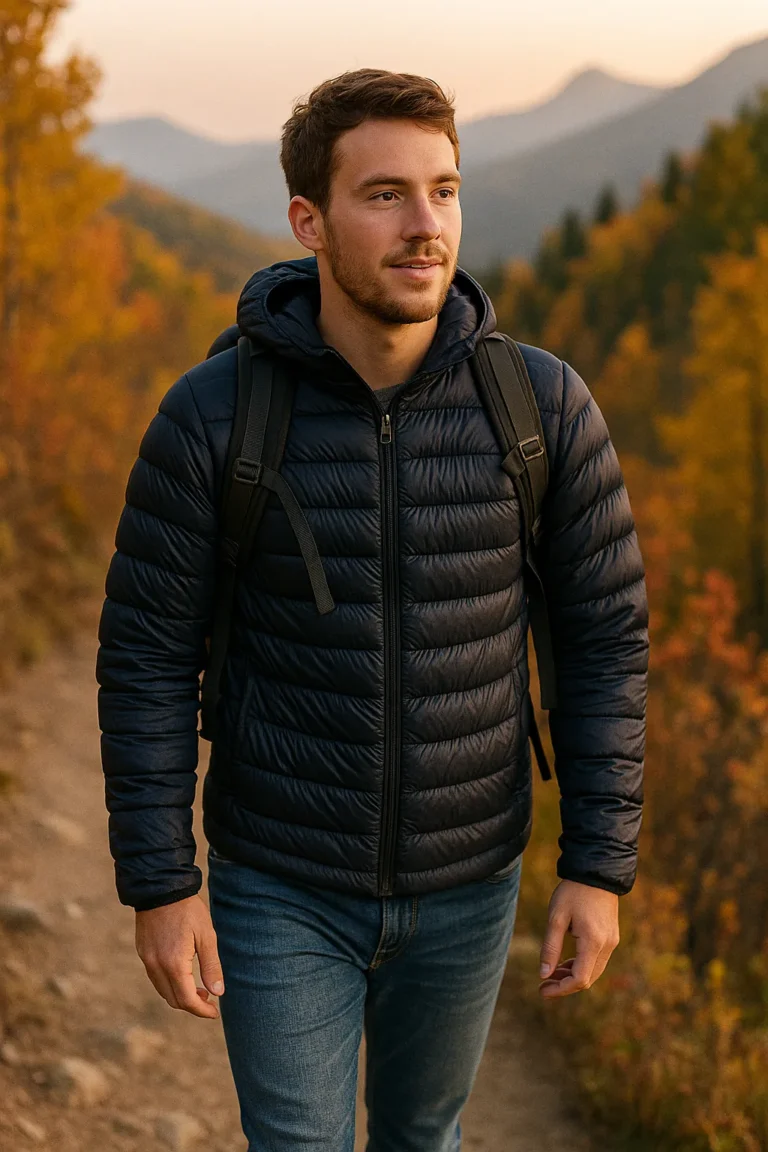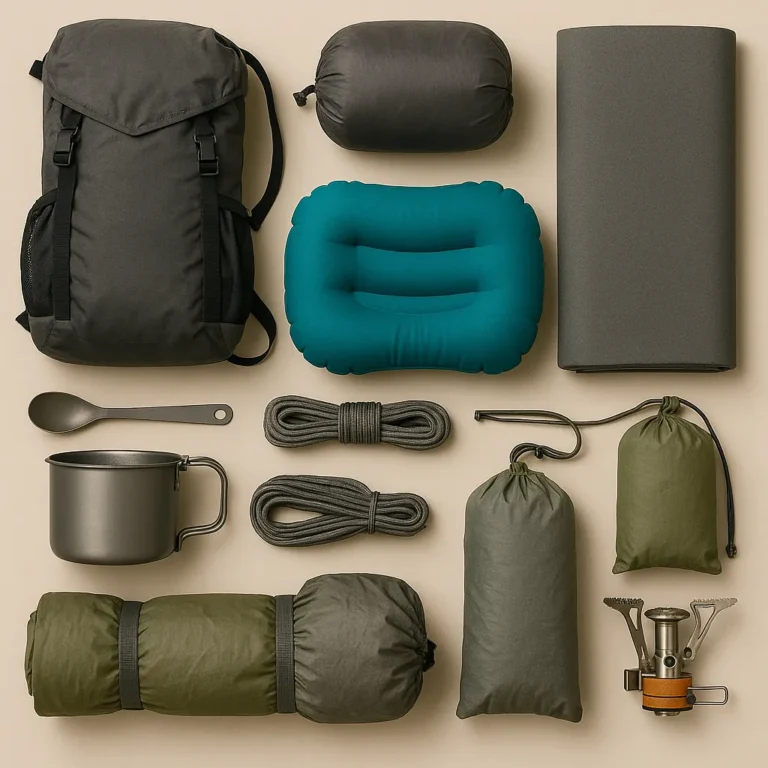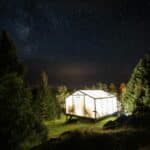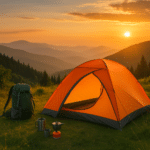Category: Gear | Type: Guide | Focus: Lightweight Binoculars for Backpacking | Time: 9 m
Last updated: April 2025
Introduction: Why Binoculars Are Worth the Weight
Backpackers are notoriously weight-conscious, so binoculars for backpacking aren’t always top of the list. But whether you’re watching mountain goats from afar, spotting rare birds in a forest canopy, or just identifying a distant ridge, a good pair of compact wildlife binoculars opens up the trail in a new way.
That said, not all lightweight binoculars are backpacking-friendly. Weight, durability, magnification, and field of view all matter more when you’re deep in the backcountry. This guide shows you exactly how to choose compact binoculars for hiking, with ultralight hiking gear recommendations and key specs explained.
Quick Comparison Table: Best Backpacking Binoculars
| Model Name | Weight | Magnification | Objective Lens | Field of View (FOV) | Waterproof | Price Range | Best For |
|---|---|---|---|---|---|---|---|
| Vortex Vanquish 8×26 | 12.7 oz | 8x | 26mm | 352 ft @ 1000 yds | Yes | $90-120 | General wildlife spotting |
| Nikon Trailblazer 8×25 | 9.9 oz | 8x | 25mm | 429 ft @ 1000 yds | Yes | $90-120 | Wide views, lightweight kit |
| Maven C.2 7×28 | 12.4 oz | 7x | 28mm | 377 ft @ 1000 yds | Yes | $400-450 | Premium optics, compact feel |
| Wingspan Scout 8×32 | 15.2 oz | 8x | 32mm | 362 ft @ 1000 yds | Water-resistant(not fully nitrogen-purged) | $80-110 | Birdwatching, budget choice |
| Zeiss Terra ED 8×25 | 10.9 oz | 8x | 25mm | 353-404 ft @ 1000 yds (varies by testing) | Yes | $350-400 | High-end clarity, ultralight |
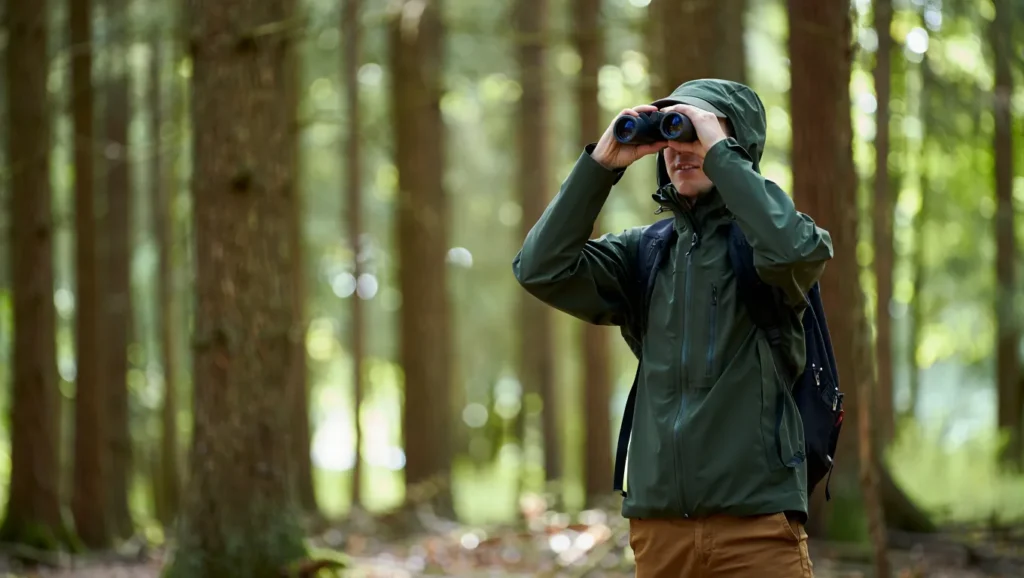
Key Features to Consider When Choosing Binoculars for Hiking
1. Magnification (8x is the Backpacker’s Sweet Spot)
When looking for portable birdwatching binoculars or general hiking optics gear, pay close attention to magnification:
- 8x magnification gives you stable, usable zoom for wildlife or landscapes without requiring a tripod
- 10x or higher increases shake and narrows the field of view—better for stationary viewing
- 7x magnification offers the widest field of view and most stable image, ideal for backcountry viewing tools
🔍 For most trail binoculars, choose 7x-8x for stable hand-held use on uneven terrain, especially when trying to spot wildlife with binoculars in national parks.
2. Objective Lens Diameter (Smaller is Lighter)
When selecting compact binoculars for hiking, objective lens size matters:
- Measured in millimeters (e.g., 25mm, 32mm)
- Bigger lenses gather more light (better in dawn/dusk), but add bulk
- For day hikes and ultralight hiking gear, 25-28mm is ideal
- For low-light wildlife viewing, consider 32mm as the upper limit for backpacking
💡 Remember: In “8×25,” 8x is magnification, 25mm is objective size. This isn’t a zoom level—it’s fixed magnification.
3. Field of View (FOV)
A wide FOV lets you easily scan ridgelines or follow moving animals—crucial when using binoculars for navigation on alpine trails or birdwatching:
- 350-450 ft @ 1000 yds = good range for outdoor magnification equipment
- Higher magnification = narrower FOV
- Wide FOV models excel when birdwatching in Yosemite backcountry or other wilderness areas
🦅 When choosing binoculars for wildlife spotting on hikes, prioritize wider FOVs, especially for moving targets like birds or animals.
4. Weight and Size
For top ultralight binoculars under 16 oz for trails, look for:
- Under 16 oz (1 lb) for backpacking—every ounce counts!
- Compact roof prism models pack better than bulky porro prism designs
- Foldable designs that fit easily in pack pockets
- Compact size that still offers comfortable grip
When considering the best way to carry binoculars on a backpacking trip, remember that every ounce saved on your optics is an ounce available for other essential gear.
5. Waterproof and Fogproof
When selecting waterproof binoculars for backpacking:
- Look for nitrogen-purged or O-ring sealed units
- Waterproof ratings ensure lenses don’t fog up on cold mornings or damp forest hikes
- IPX7 or higher rating is ideal for serious durable trail binoculars
- Consider how to clean binoculars after a desert hike or rainy adventure
Always check the waterproofing before buying, as waterproof binoculars for backcountry camping protect your investment in challenging conditions.
6. Durability and Grip
For durable trail binoculars that can handle rough treatment:
- Rubber-armored housings resist drops and improve grip
- Folding hinge or dual-hinge designs pack smaller
- Shock-resistant construction withstands bumps on the trail
- Non-slip texturing helps in wet or sweaty conditions
7. Optical Quality (ED Glass & Coatings)
For those investing in premium outdoor magnification equipment:
- Higher-end models offer ED (extra-low dispersion) glass for better color and clarity
- Look for fully multi-coated optics to reduce glare and increase light transmission
- Phase-correction coatings improve contrast and detail in roof prism designs
- BaK-4 prisms offer better light transmission than BK-7 glass

Best Use Cases for Backpacking Binoculars
Wildlife Spotting in National Parks
When spotting wildlife with binoculars in national parks, use 8×25 or 8×32 for elk, deer, or raptors. Wide FOV and waterproofing are key for all-day use in variable conditions.
Top pick: Vortex Vanquish 8×26 – The perfect balance of weight, durability, and optical clarity for general wildlife viewing. Many hikers report excellent performance when using binoculars for wildlife spotting on hikes.
Birdwatching on the Trail
If you’re searching for the best portable birdwatching binoculars, look for wide FOV, close focus under 10 ft, and true color fidelity.
Top pick: Wingspan Scout 8×32 – Offers excellent color reproduction and enough light gathering for spotting birds in forest canopies. Perfect for using binoculars for birdwatching while hiking.
Alpine or Ridgeline Viewing
When choosing top binoculars for ridge viewing in the Rockies or similar terrain, smaller 25mm lenses keep weight down but give enough range to scope distant features.
Top pick: Zeiss Terra ED 8×25 – Premium optics in an ultralight package make this ideal for backcountry viewing tools where clarity at distance matters.
Desert or Open Terrain Scouting
For best binoculars for desert hiking under 12 oz, dust resistance and long-distance clarity help in open landscapes.
Top pick: Maven C.2 7×28 – Outstanding edge-to-edge clarity and robust construction make these perfect for harsh environments. Many users report excellent results when using these as waterproof binoculars for rainy forest hikes as well.
How We Evaluate Backpacking Binoculars
Our recommendations are based on (based on author expertise and general industry standards):
- Weight and packability measured on calibrated scales
- Optical clarity assessed in various lighting conditions
- Durability testing including water exposure and minor drop tests
- User comfort for extended viewing periods
- User feedback from dedicated hikers, birders, and naturalists
We prioritize models that balance weight reduction with usable performance—the true measure of effective lightweight binoculars.
Pro Tips for Carrying and Using Binoculars on the Trail
- Use a chest harness or elastic neck strap to avoid bounce
- Keep a lens cloth in a Ziploc to wipe off dust or fog
- Don’t store wet—always air-dry after use
- For ultralight hikers: consider compact binoculars vs monoculars for ultralight hiking, but expect limited performance with the latter
- When learning how to clean binoculars after a desert hike, use a soft brush first to remove grit before wiping lenses
Real-World Hiker Feedback
- AT hikers report Nikon Trailblazers as budget-friendly and surprisingly sharp for portable birdwatching binoculars
- Backpackers in Yosemite praised Maven’s sharpness for bear-spotting from a distance when using binoculars for wildlife spotting on hikes
- Ultralight minimalists found Zeiss Terra the best balance of clarity and compactness when selecting top ultralight binoculars under 16 oz for trails
- Desert campers appreciated the rubber armor and grit resistance of the Vortex Vanquish as durable trail binoculars
- Birders on weekend hikes liked the Wingspan for its crisp color and wide view on a budget, perfect for birdwatching in Yosemite backcountry
“I never thought 10 ounces would add so much to my hiking experience. The Nikon Trailblazers let me spot a peregrine falcon at 200 yards—worth every ounce in my pack.” —Sarah K., Colorado Trail thru-hiker
Choosing Between Popular Models
When comparing the Vortex Vanquish vs Nikon Trailblazer for backpacking, consider:
- Vortex offers better durability and warranty
- Nikon provides wider field of view and weighs less
- Both are excellent choices under $200
For premium options, the Maven C.2 vs Zeiss Terra for backcountry clarity comparison shows:
- Zeiss offers slightly lighter weight (10.9 oz vs 12.4 oz)
- Maven provides more light transmission with larger objectives
- Both deliver exceptional clarity, but Maven’s warranty is superior
If debating between magnification levels, remember that 7x vs 8x binoculars for hiking in rugged terrain comes down to:
- 7x provides wider field of view and more stable image
- 8x offers slightly more reach for distant subjects
- Most hikers prefer 8x as the sweet spot
Conclusion: A New Way to See the Trail
Backpacking binoculars aren’t just for birders—they’re tools for immersion, orientation, and surprise encounters on the trail. Whether you’re scanning a ridge, watching a hawk spiral, or simply taking in a distant waterfall, the right pair of lightweight binoculars turns every hike into a richer experience.
When choosing the best lightweight binoculars for backpacking 2025, remember that the perfect pair balances weight, optical quality, and durability. The few ounces they add to your pack will reward you with countless memorable wildlife encounters and hidden details you’d otherwise miss.
🎯 Ready to complete your field gear kit? Explore:
- Best Camping Flashlights with Long Battery Life (2025)
- Best Backpacking Hammocks Under 1 lb (Ultralight & Trail-Tested)
- Top 7 Compact Camping Gadgets You’ll Actually Use in 2025
FAQ: Backpacking Binoculars
Q1: Are binoculars worth the weight for backpacking?
Yes—if you’re into wildlife, navigation, or birding. A 10 oz pair adds more enjoyment than many gadgets and opens up new dimensions to your hiking experience.
Q2: What’s the best magnification for hiking use?
8x hits the sweet spot between range and stability for handheld use on trails. This is ideal for most backcountry viewing tools.
Q3: Are monoculars a good alternative?
Only for ultra-minimalist hikers looking for the absolute lightest option. When considering compact binoculars vs monoculars for ultralight hiking, remember that monoculars are lighter but usually worse in FOV, clarity, and comfort.
Q4: Can I use full-size binoculars on long hikes?
Technically yes, but they’re heavy (1.5-2 lbs). Compact models under 16 oz are better for backpacking as true ultralight hiking gear.
Q5: Do I need tripod compatibility?
Not for backpacking. Handheld use is the norm—tripods are better for birding blinds or basecamps. Most portable birdwatching binoculars are designed for handheld stability.
Q6: How should I protect my binoculars in wet conditions?
Choose waterproof binoculars for backcountry camping with IPX7 ratings or higher. Keep them in a waterproof case when not in use, and remember to use the included lens caps.
Q7: What’s the best way to carry binoculars while hiking?
A chest harness is ideal for quick access without neck strain when determining the best way to carry binoculars on a backpacking trip. Side pockets or hip belt attachments also work well.

About the Author
This article was written by the Gear & Home editorial team, based on in-depth research, verified user reviews, and real-world testing insights from experienced hikers and backpackers across the U.S.
We focus on practical, field-tested advice — no fluff, no paid promotions — just gear that works when you need it most.


